The fortress castle where the Crusades passed and the Muslims won
Standing among the rugged landscapes of central-western Syria, on a natural top, stands a testament to the military prowess and cultural exchange of the Middle Ages: the fortress fortress. Originally built for the Emir of Aleppo in 1031, this majestic castle later became the headquarters of the famous Hospitaller knights during the twelfth and thirteenth centuries.
Show key points
- Originally constructed in 1031 for the Emir of Aleppo, Qal'at al-Hisn was later transformed by the Knights Hospitaller into a nearly impregnable Crusader stronghold.
- The Hospitaller Knights extensively rebuilt the fortress with concentric walls, towers, and defensive innovations, reflecting a blend of European and Islamic architecture.
- Serving not just as a military bastion, the castle also functioned as a center for administration, religious practice, and community life during the Crusader period.
- ADVERTISEMENT
- Strategically located between Tartus and Tripoli, the castle allowed the Crusaders to control trade routes and monitor border movements, making it a bulwark against Islamic expansion.
- Significant battles, including the 1163 victory over Nur ad-Din and the eventual 1271 fall to Mamluk Sultan Baibars, highlight its role in crucial historical conflicts.
- The hierarchical design of the castle's living spaces, from common dormitories to master residences, reflected the structure and social order of the Knights' system.
- Now recognized as a UNESCO World Heritage Site, the fortress endures as a cultural and historical monument symbolizing medieval power, interfaith encounters, and architectural brilliance.
The origins of the castle
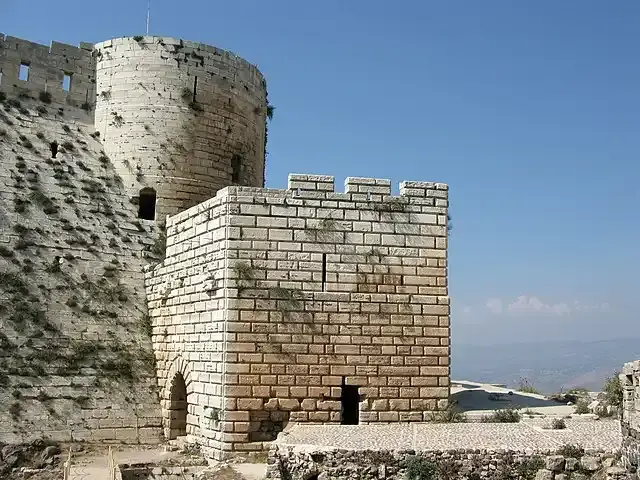
The story of Qal'at al-Hisn begins with the Emir of Aleppo who built the castle on a former fortification site. However, fate had other plans. In 1144, ownership of the castle changed when it was widely acquired and rebuilt by the Knights Hospitaller. These warrior monks turned it into a formidable, virtually impregnable, stronghold and a strategic location to guard the eastern border of Tripoli province – one of the states established by the Crusaders in the Levant.
Recommend
The acquisition of the Knights Hospitaller marked a turning point in the history of the castle. They recognized its strategic importance and set out to strengthen its defenses. The Knights Hospitaller was a military religious system dedicated to providing medical care to pilgrims and defending Christian lands in the Holy Land. Their presence in the fortress fortress transformed it from a territorial stronghold into a crucial stronghold of crusader power.
The Impact of the Knights Hospitaller
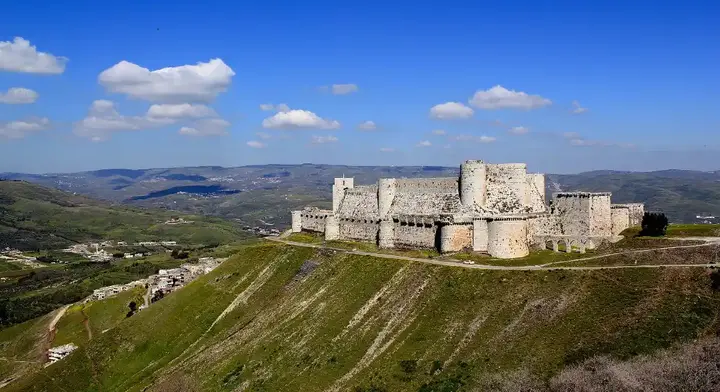
Under the Knights Hospitaller, the fortress fortress became more than just a military outpost; it was a center of administration, culture, and faith. The castle housed not only knights, but also craftsmen, servants and administrators. Its strategic location near the coast allowed it to control vital trade routes and monitor movements along border areas.
Hospitaller Knights began rebuilding the castle in the forties of the eleventh century, reinforcing its walls, adding towers, and creating a concentric design. The outer curtain wall, internal protection and multiple layers of defense made it almost impervious to the siege. The architecture of the castle reflects European and Islamic influences, showcasing interactions between cultures of the time.
The Impact of the Knights Hospitaller
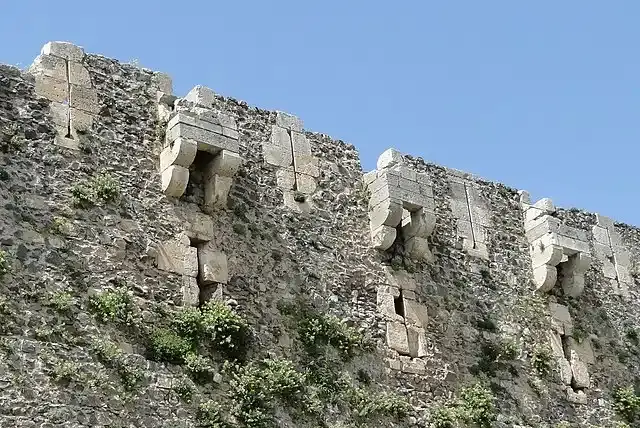
Under the Knights Hospitaller, the fortress fortress became more than just a military outpost; it was a center of administration, culture, and faith. The castle housed not only knights, but also craftsmen, servants and administrators. Its strategic location near the coast allowed it to control vital trade routes and monitor movements along border areas.
Hospitaller Knights began rebuilding the castle in the forties of the eleventh century, reinforcing its walls, adding towers, and creating a concentric design. The outer curtain wall, internal protection and multiple layers of defense made it almost impervious to the siege. The architecture of the castle reflects European and Islamic influences, showcasing interactions between cultures of the time.
Center of power
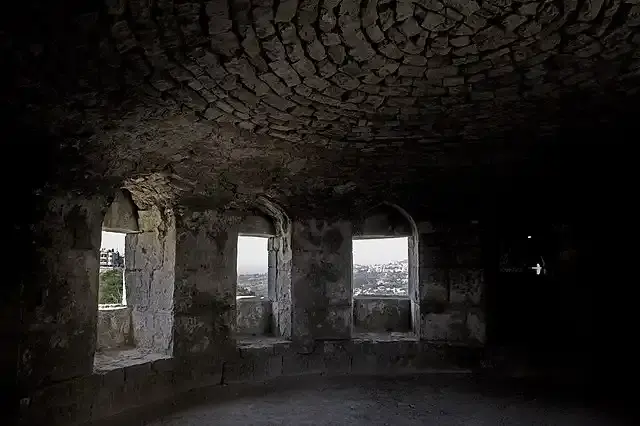
The fortress fortress served as more than just a military base. It was a focus of activities that included:
Chapel: Within the castle was a chapel where the knights could pray and find consolation. His simple and elegant design emphasized their dedication.
Great Hall: A large hall that served as a common venue for meetings, banquets and gatherings. Here, the knights discussed strategy, celebrated victories, and planned campaigns.
Living quarters: The castle housed cavalry, escorts and other staff. Private rooms, shared dormitories and kitchens fill the interior.
A bulwark against Islamic expansion
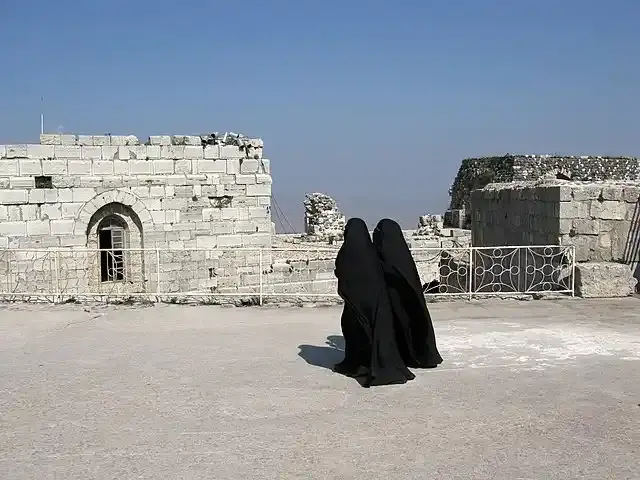
The fortress fortress was more than just a fortress; it was a bulwark against the expansion of Muslim states. Its location near the coast between Tartus and Tripoli allowed it to control vital access routes. As a permanent garrison of Hospitallers, it posed a military threat to any army passing through the region. The castle's influence extended even further, encompassing the lands of the Assassins, a Muslim sect that pays an annual tribute to the Hospitallers.
At its peak, the fortress fortress housed about 2,000 people, including cavalry, infantry, crossbow specialists, and mercenaries. It is noteworthy that the real number of the knight brothers did not exceed sixty, but their courage and determination made them a greatness in the throat of Muslims, as described by the historian Ibn al-Atheer in 1170
Architectural marvel
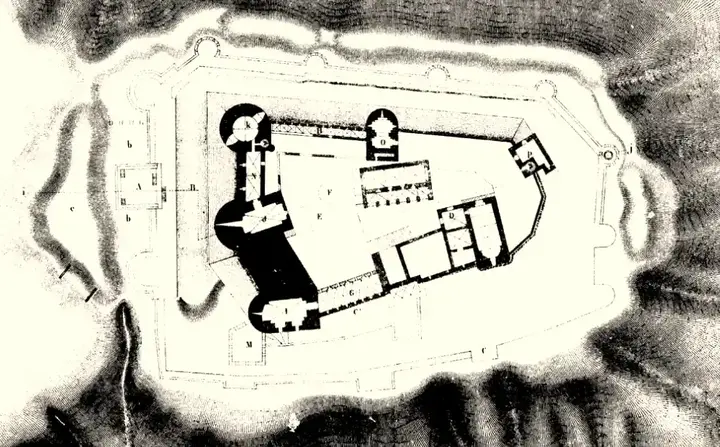
Fort Al Hisn is a great blend of European and Islamic architectural styles. Its massive ramparts, majestic towers and complex defensive characteristics reflect the ingenuity of medieval military engineering. Let's dive deeper into the architectural complexities:
Gate Tower: One of the reconstructed elements, the Gate Tower that now serves as an entrance. It is a large quadrangular tower that stands out slightly and is protected by three lattices. The gate tower had a crucial role in controlling access to the castle and ensuring its security.
Toilet Tower: The lack of toilets in the large hall on the first floor of the East Tower suggests that it could have been a residence for warrior monks. The lack of such facilities indicates that cleanliness was not a priority in this space, underscoring its military function.
Chapels decorated with frescoes: These sacred spaces within the castle display intricate frescoes that reflect religious devotion and artistic skill. The combination of military power and spiritual expression emphasizes the dual purpose of the fortress fortress.
Defense Innovations
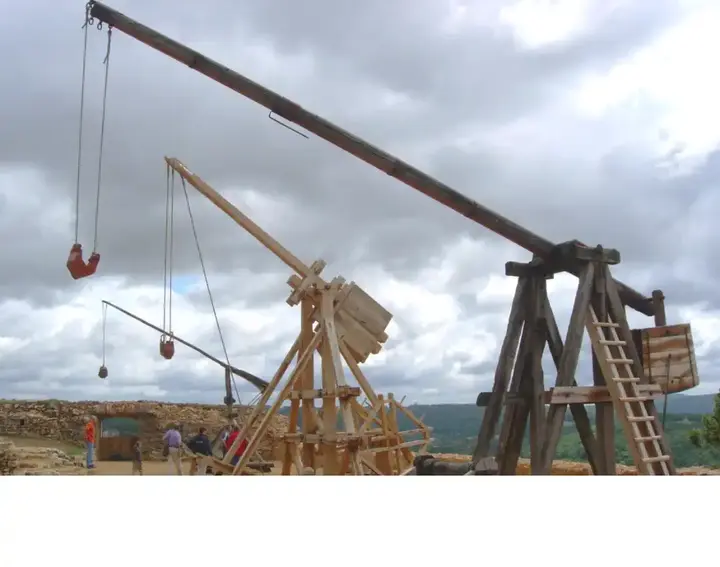
Fort Al Hosn has several innovative features that distinguish it as a military marvel:
Multiple quarries: The surviving castle contains two concentric perimeters, 300 meters long at the longest point and 140 meters at the widest point. These multiple layers of defense made it almost impervious to the siege. The outer curtain wall, inner fortress, and additional fortifications created a formidable barrier against attackers.
Strategic location: The castle's location on top of a steep hill offers a magnificent view of the surrounding landscape. Its height allowed defenders to observe movements along the border territory and detect approaching armies. The strategic location near the coast also allowed the city of Al Hosn to control vital trade routes.
Gate Design: The gate tower, rebuilt by the Hospitaller Knights, served as the entrance. It was a large quadrangular tower that was slightly protruding and protected by three lattices. The guard room included features such as a drawbridge, gate, and kill hatchs to thwart attackers.
Arrow notches and crossbow edges: The castle walls were studded with narrow arrow notches and crossbow edges. These openings allowed defenders to throw arrows and nails at the trapped while remaining protected behind thick walls.
Barbican and killing zones: External defenses included barbicans – small fortified outposts – designed to delay and weaken attackers. These killing areas forced the invaders to expose themselves to concentrated defensive fire before reaching the main castle gate.
The role of the castle in a number of specific battles
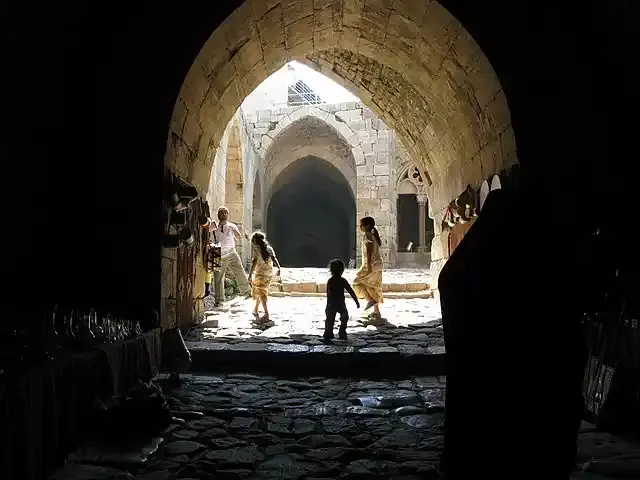
Battle of al-Bqai'a (1163): The Crusaders defeat Nur ad-Din near Qal'at al-Hosn, and this victory strengthens their control of the area. The battle showed the strategic importance of the fortress in the defense of the Crusader states.
Siege of the Mamluk Sultan Baibars (1271): After a 36-day siege, Baibars captured the fortress fortress. The Mamluks used siege machines, including catapults and manganels, to penetrate the walls. A forged letter purportedly from the Grand Master of the Knights Hospitaller led to the Knights surrendering. The fall of the fortress fortress marked the decline of Crusader power in the Levant.
The hierarchical living spaces in the castle that reflect the structure of the cavalry system:
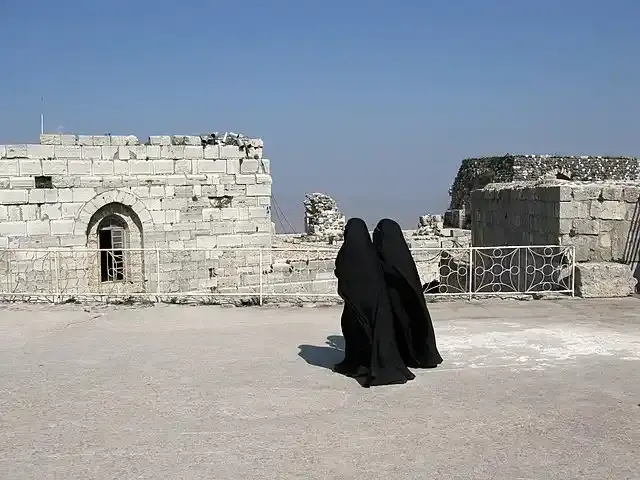
Common Dormitory: A large hall with a vaulted ceiling that served as a dormitory for warrior monks. The simplicity of this space contrasts with the grandeur of the church and other ceremonial areas.
VIP accommodation: It is likely that the lofts were intended for VIPs, including a ballroom and a residence for the castle or master. These rooms could have been more comfortable and private than the dormitory.
Grand Master Residence: The elegant round room on the second floor of the southwest tower may have hosted one of the great masters during his visits. Its design would have reflected functionality and prestige.
Retreat and fall
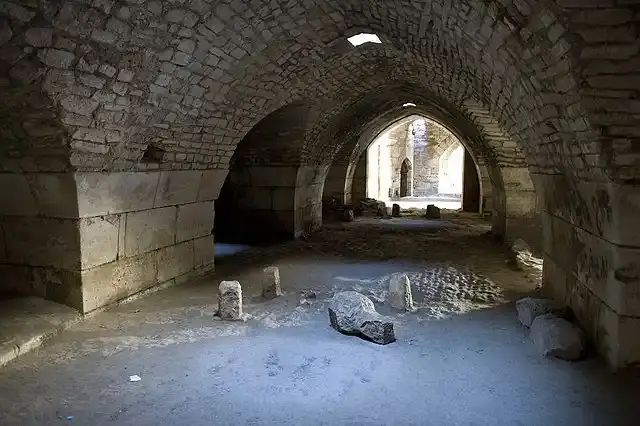
Despite its strength, the fortress castle faced many challenges. In the middle of the thirteenth century, the tide turned against the Crusaders. The rise of powerful Muslim leaders such as Sultan Baibars threatened their grip on the Levant. In 1271, after a 36-day siege, Baibars captured the citadel. The surrender of the Knights Hospitaller marked the end of an era.
Current status and heritage
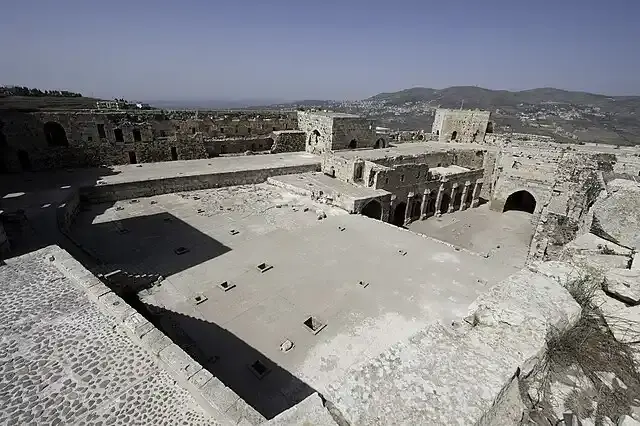
Status and restoration:
The castle has survived centuries of conflict, religious division and occupation. It remained in use until the nineteenth century.
Unfortunately, earthquakes caused some damage to the castle over time.
In the late nineteenth or early twentieth century, a settlement was established inside the castle, further eroding its fabric.
However, efforts have been made to restore and preserve the fortress and are now accessible to visitors.
UNESCO's classification of the castle as a World Heritage Site:
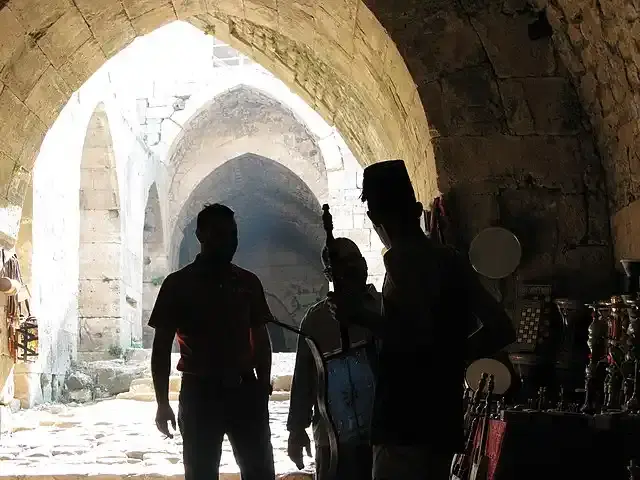
Since 2006, both Qal'at al-Hisn and Qal'at Salah al-Din (another castle nearby) have been recognized by UNESCO as a World Heritage Site.
This ranking highlights its cultural and historical significance on a global scale.
Significance and symbolism:
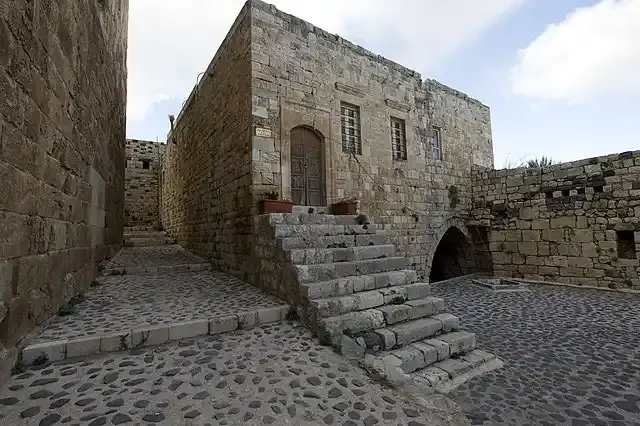
The image of the majestic castle against the Syrian sky is a silent witness to the Crusades, the clash of cultures, and the enduring spirit of those who defended their faith and ideals.
Its architecture combines elements of European and Islamic styles, reflecting the interactions between cultures of its time.
Heritage:
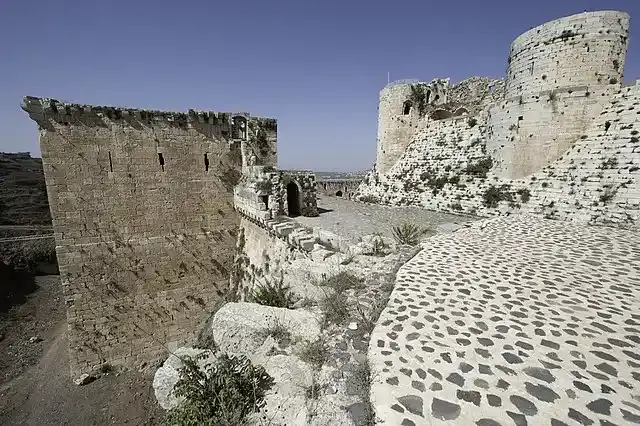
The fortress is reminiscent of the era when the Knights set out to protect Christendom, leaving behind a legacy carved into stone.
Today, the citadel remains a powerful symbol of interactions between Christians and Muslims in the Middle East.
In short, the fortress castle remains a fine example of medieval military architecture, inviting visitors to explore its rich history and appreciate its enduring importance.








